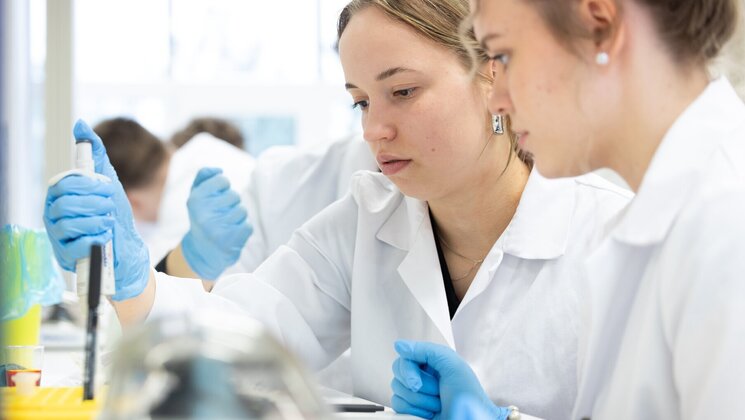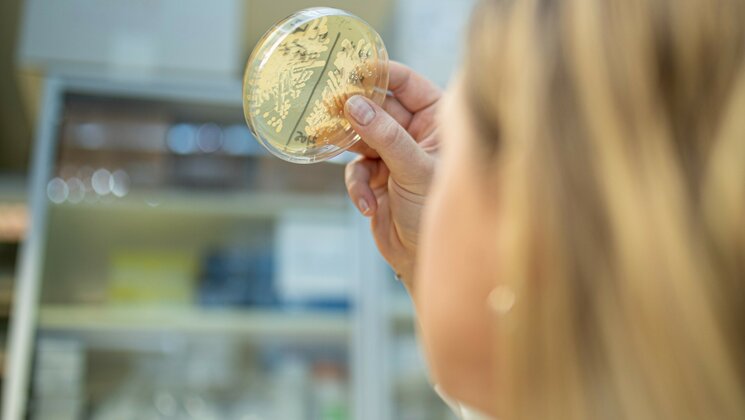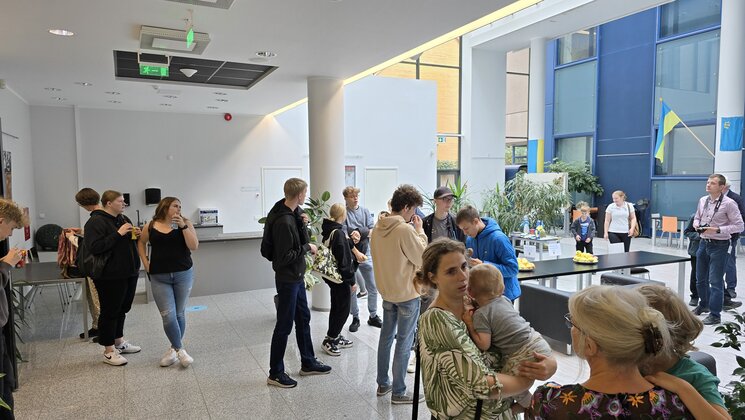A lot of enthusiasts gathered to the Researchers’ Night

On September 29, 2023, a family day and a Researchers’ Night was celebrated in our institute for the second time. The event brought together a hundred of science enthusiasts, mostly school students as the primary target audience.
The photo gallery of the event (at the bottom of the page)
The workshop "Honey and Microbes" results
The afternoon event was opened by the director of the Institute of Molecular and Cell Biology at the University of Tartu, Professor Maia Kivisaar, who expressed her delight at the high number of participants. According to Maia Kivisaar, Researchers' Night is an excellent opportunity to invite people who maybe pass by our institute in the middle of the town every day but do not yet know about our activities. Following her, the event organizers, represented by project manager Teele Eensaar, deputy director Margus Leppik, and communication specialist Ermo Leuska, addressed the enthusiastic guests, giving them a glimpse of what would happen during the afternoon and why it's worth visiting us in the future as well.
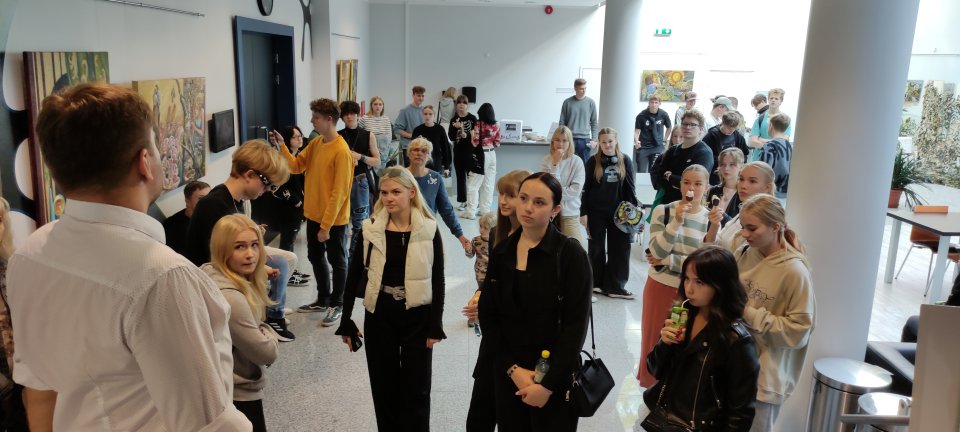
In the Omicum Gallery, the attendees could enjoy the spetaculous taste of icecream factory Balbiino’s ice creams.
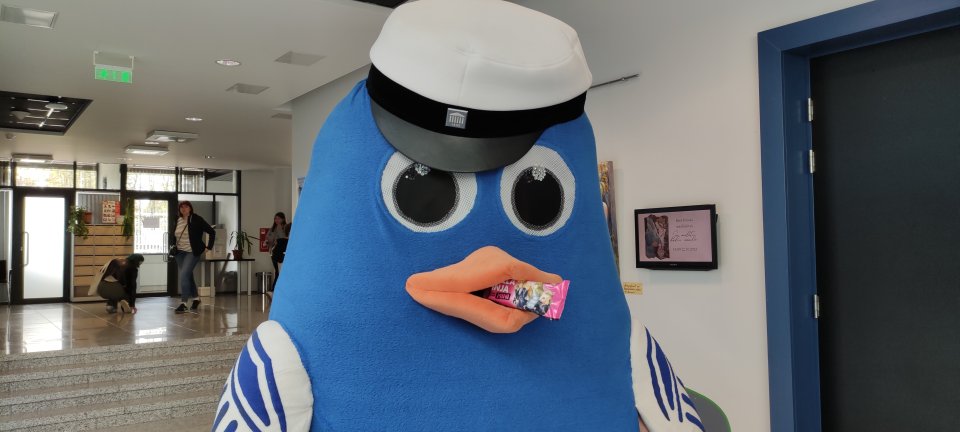
Following that, a tour of the institute's study and research buildings took place, accompanied with the university mascot TIKSU. Participants visited the student room, explored the laboratories of genetics and molecular biology, took a look at indoor health trail, and admired the art exhibition at the Omicum Gallery.
From 3 PM to 5 PM, eight workshops were conducted on four different themes:
.
The workshop "Honey and Microbes"
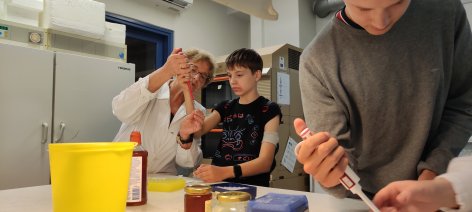
The workshop explained which sugars make honey sweet, which bacteria survive in honey and how they manage to do so. In the workshop, the composition of sugars in honey and sugar syrups was analyzed using thin layer chromatography, and spore-forming bacteria that are possible to find in honey were observed under a microscope. Pictures of the bacteria on slides inspected during the workshop can be found in the photo gallery of the event.
Conductors: Associate Professor of Microbiology Triinu Visnapuu and Genetics Researcher Anne Menert
The workshop was supported by the Estonian Society for Microbiology and the CELMS Microbial Collection. The workshop also belonged to the programme of the International Microorganism Day event.
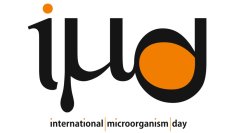
The workshop "Meeting Your Own Microscopic World"
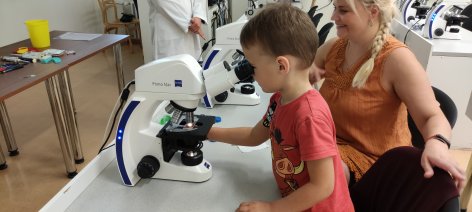
In this workshop, microscopes were used to examine participants' cheek cells. The location of the cell nucleus, which contains 46 chromosomes or our DNA, was observed. Additionally, participants were introduced to the world of bacteria that constantly accompanies every individual. Attendees had the opportunity to 'cultivate' microbes from their own hands by touching a special nutrient medium. Later, they compared it with a clean, untouched sterile medium.
Conductors: Engineer Dmitri Lubenets, Research Fellows Signe Värv and Henel Jürgens, Laboratory Specialist Ingrid Kalmre and doctoral student Darja Vastšjonok
The workshop: "Fruit Flies: Tiny Gems to Understand Humans"
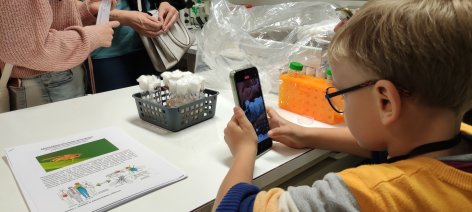
In the Drosophila workshop, attendees had the opportunity to peek into the mystical world of scientists and learn how the familiar fruit fly, with the smiliarity of 65% of the genes of a human, helps to discover and even solve fundamental biological questions. The workshop explored how these tiny, valuable model organisms are bred, studied, and used in scientific research. Additionally, participants learned how the knowledge gathered about the fruit flies help to understand the information about human diseases, aging and evolution.
Conductors: Associate Professor of Developmental Biology Tambet Tõnissoo, doctoral student in Developmental Biology Hanna Antson, and undergraduate students Robin Sarv and Lonaly Jüriado.

The workshop was conducted in collaboration with the international project:
Science and Education Awareness Initiative Based on Fruit Fly Research in Estonia.
Project period: 01.06.2023 - 31.05.2024
The workshop "Exploring DNA"
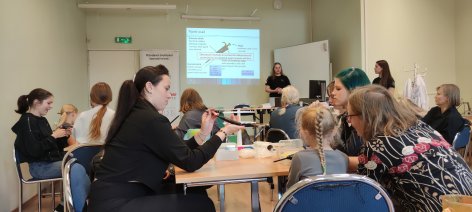
In the workshop, participants used practical tools to make their own DNA visible and engaged interactively in uncovering the secrets hidden within DNA. Participants were introduced to the technical gadgets used in the laboratory, which they could also try out for themselves.
Conductors: Members of Mobile Bioclass: Kethel Monso, Maarja Runtal, Andres Reintam
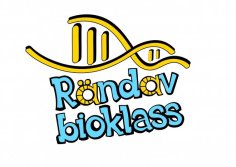
ASK A SCIENTIST
For the first time, the initiative 'Ask a Scientist' took place, inviting everyone to submit questions both online and on-site, to which our institute's scientists could provide answers.
Read the questions and answers:
Question: Which bacteria does a person have more - those that are bad or those that are useful?
Associate Professor in Genetics, Ph.D. Riho Teras:
In short, we know the so-called harmful bacteria better than the beneficial ones. Therefore, it seems that there are many harmful ones.
First, we (humans) know a negligible fraction of the bacteria that live on planet Earth, including the bacteria that live in/on humans. Only a small proportion of bacteria can be grown outside the body and studied in the laboratory. In other words, we still don't know all the bacteria or their behavior in our body. According to more recent calculations, there are about as many bacteria on our body surfaces and in our bodies as human cells. So there are many bacteria, and the number of them that we do not know is also large.
Secondly, we know quite well the bacteria that harm the human body, and research groups have focused on them. Useful ones or those that are in our body/body but do not affect us in any way are not talked about. You can also think that if there were more harmful than useful, we would be constantly sick. Therefore, there are definitely very few bacteria on and in our body that harm us, compared to those that benefit us or do not affect us.
Question: If you look into the light, you can see specks in the eye, what could it be? The KSA eye clinic has talked about floaters. The doctor himself does not see them, but has written articles based on what others have said. Could you please comment a little on the topic: floaters in the eye when looking at the light and microscope. Many thanks! I love the University of Tartu and science! Thank you!
Associate Professor in Developmental Biology, Ph.D. Tambet Tõnissoo:
The gel-like vitreous of the eye can contain so-called "floaters" (collagen fibers stuck together), which a person sees as threads, strings, spots or dot-like circular floating/floating formations that move when the eye is moved or sink down when the eye remains still, they stand out especially well in bright light (microscope, white snow, etc.). If such a "floating" shadow falls on the retina, the person perceives it as a dot/hair/thread formation. Can occur in both younger and older people. Generally, this is normal physiology that does not require intervention. In older people, the quality of the vitreous also begins to degenerate and "floaters" may occur more often. In general, the human brain gets used to them and is plastic enough to reduce the noise background.
Question: Why do moths come to the light at night, but do not fly during the day when it is light?
Professor of Entomology Ph.D. Toomas Tammaru:
Everyone knows that night-flying insects gather near light sources and often cannot leave. Strangely enough, the phenomenon could not be convincingly explained for a long time. It has been suggested that:
1) insects fly to the direction where there is more light at night simply because it is the easiest way to find a way back to the "free air space" suitable for long-distance flight after staying near plants and inside vegetation;
2) insects use the moon or the brightest direction in the sky to keep a certain course: by keeping a certain angle to the moon, the insect flies straight, but if in practice there is an imaginary light source instead of the moon, which is infinitely far away, such keeping an angle leads to a spiral approach to it;
3) insects come into the area of influence of light randomly, and abnormally strong light for them blinds them to such an extent that they cannot go forward or back.
All this and some others have been considered, but these explanations are not convincing. But - just now a research has been completed (not yet finally published, "preprint"), which shows that flying to the light is well explained by assuming that the insect keeps its back towards the sky to maintain a vertical body position. If the light source is brighter than the sky, the insect starts to hold its back towards it, which affects the flight path in such a way that the insect finally reaches the light source. The coming years will show whether such an explanation will be generally accepted, but in any case, it is probably the most serious scientific work on the subject in question.
But why don't moths fly towards the light during the day? Well, that's because they are not active at all during the day, primarily to avoid being eaten by birds!
Question: Hello! I would like to ask IMCB's researchers how they cope with work stress, in other words - how to stay in the moment (in the laboratory, in the lecture hall) and not with thoughts about the past or the future.
Research Fellow of Cell Biology, Ph.D. Signe Värv:
What causes a researcher's work stress? Certainly, if some experiment that you have been doing for a long time fails (well, for example, 15 minutes before seeing the test result, the test tube slips from your hand and breaks, and everything important inside finds its way into the waste bin instead :) Or if the test results do not reproduce (this is very scary!) and the work does not move forward in any way. The stress comes, if you want to make an experiment in the laboratory, but you also need to read a lot of scientific literature so that your laboratory work would make sense. Both activities take a lot of time. And then the constant and more indirect stress is that there is always the worry of whether or not your research group will be able to get the money to work for the next couple of years.
If the experiment goes wrong, nice co-workers definitely help with stress. You can complain to them about your concerns and they must all have struggled with the same problem and know how you feel. In addition, you can discuss with them what could be done differently or how to organize the work better, so that none of the test tubes can't slip anywhere :) I am very lucky - I have very, very nice co-workers whom are always a pleasure to see when I come to work in the morning. More like friends than just colleagues. The fact that time is short is already a more difficult problem. But here you need to use reasonable time planning and the realization that you cannot do everything in the world. And again, coworkers are also helpful - you managed to read two of the three articles yourself, but your colleague again reviewed the third one, and now you can share new knowledge with each other faster. And in fact, you learn to live successfully with a small constant feeling of guilt that you are doing something other than reading a scientific article :) And if in the end this failed experiment still succeeds and several more times in a row, it is nice to know that for a moment you are the only person in the world who has some new piece of information and the joy of the result that comes with it help to erase all kinds of previous accidents. When your own work is published in a magazine - it's very cool. From this feeling, you can continue working for a while. And you have to like this job - it keeps your thoughts in the right place. The more you know, the more you want to know...
The most difficult thing to fight against is the stress of research funding - you can just work as well as you can and hope that maybe it will go well... And if it doesn't, there are actually many more doors open for a researcher than just the university...
If the stressors of life outside of work tend to come to work, then more serious stress reduction techniques must be taken - go to the forest, take a walk, exercise, take a winter bath, read fiction, talk with friends. As always - no scientist is an ordinary person. However, the wonderful thing about my workplace is that if I feel like I need to take a short walk in the middle of the day to get my thoughts back on track, I can just get up and go - I can organize my time as I need, and that is a very big and pleasant freedom.
Question: What were your first feelings when you found out that you were hired as a researcher at the University of Tartu?
Associate Professor in Genetics, Ph.D. Hedvig Tamman:
My first feelings when I was hired at the University of Tartu upon returning from abroad were joy, appreciation and confidence. Joy, because I was able to do the work I wanted at the University of Tartu. Appreciation, because I am proud to be able to work at the university and it is nice to feel worthy of something big. Confidence, because having also studied at the University of Tartu, I knew where I was coming, what was waiting for me and with whom I had to work.
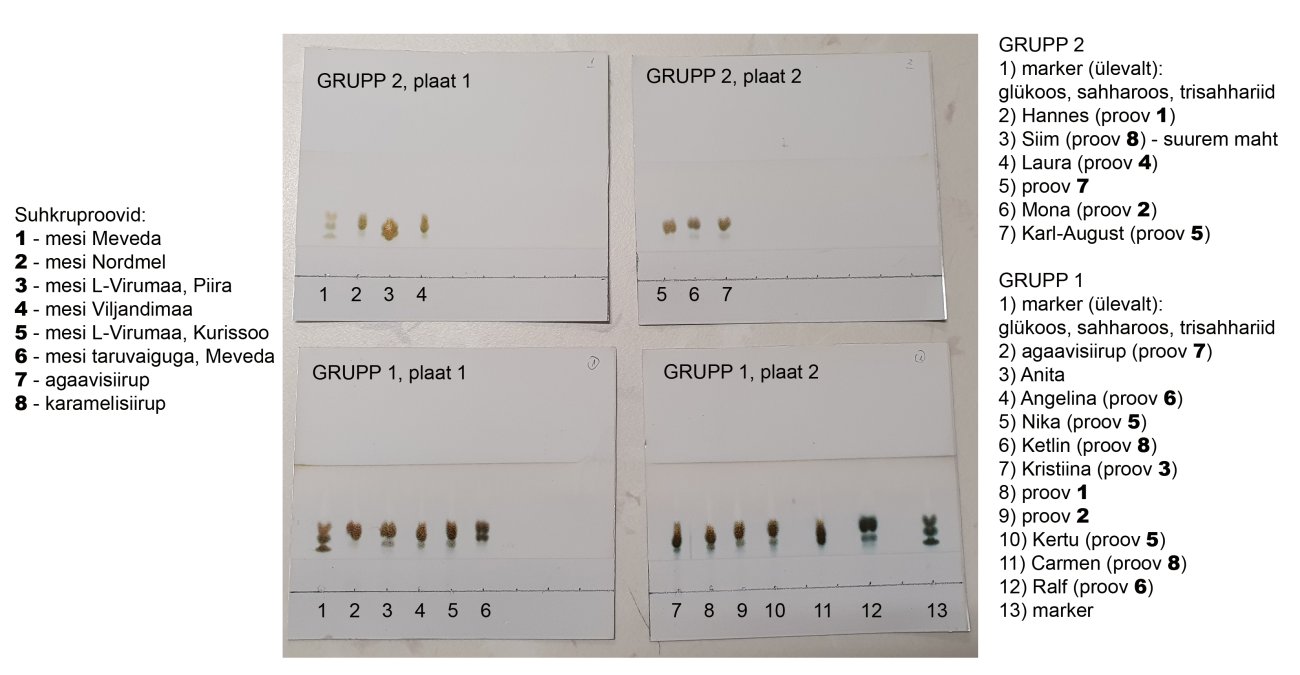
In the workshop "Honey and Microbes", the composition of sugars in honey and sugar syrups was analyzed using thin layer chromatography, and spore-forming bacteria that are possible to find in honey were observed under a microscope. Pictures of the bacteria on slides inspected during the workshop can be found in the photo gallery of the event.
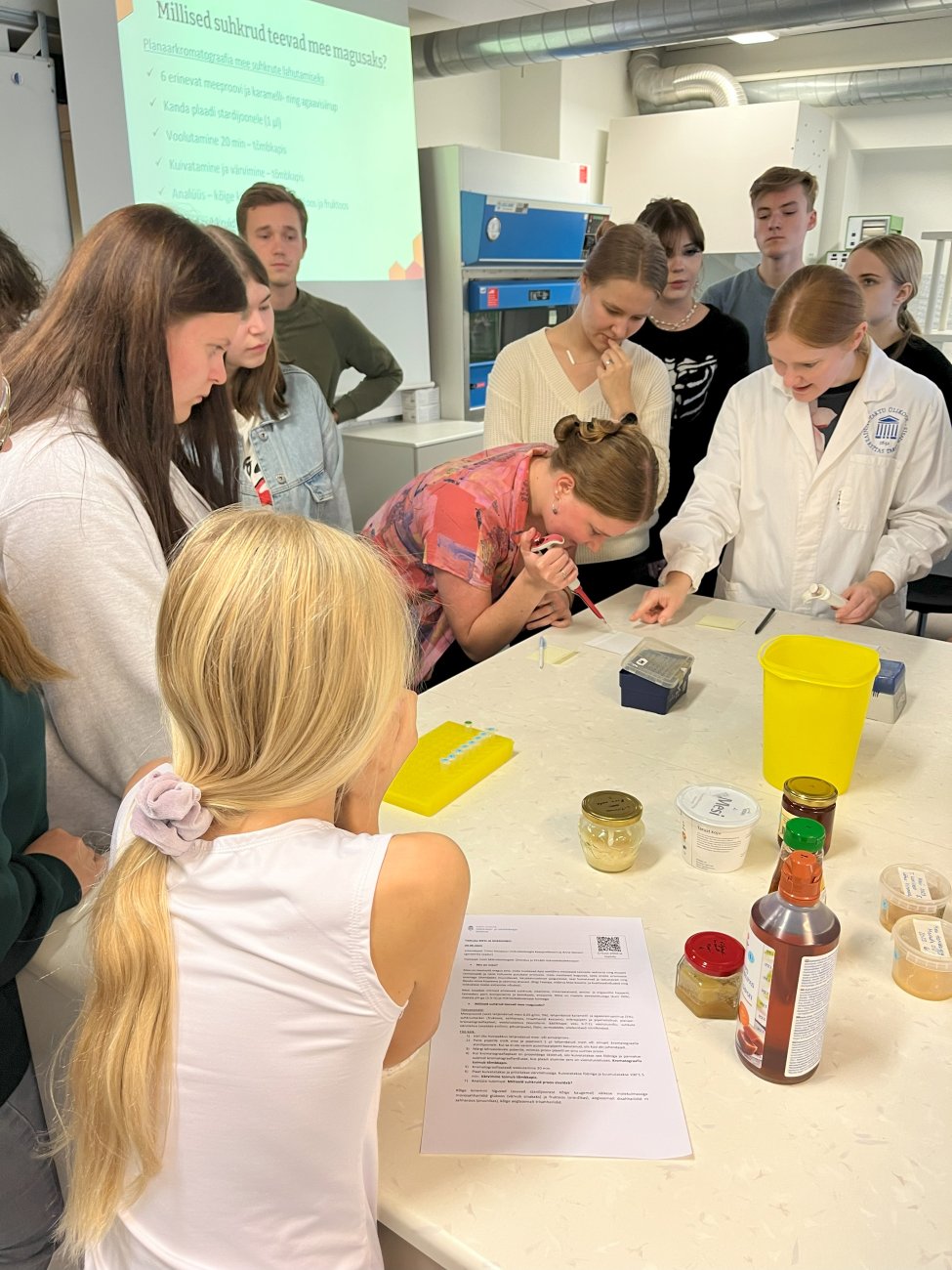
One of the participants of the Researchers’ Night wrote a comment (in Estonian):
Osalesin Teadlaste Öö festivali raames toimunud TÜMRI Teadlaste Öö töötubades ja perepäeval tegelikult täiesti esimest korda ning sain piiluda korraks sellesse põnevasse ja kihilisse maailma, mis on alati nii salapärane tundunud.
Tartu Ülikooli Molekulaar- ja Rakubioloogia instituut korraldas väga meeleoluka pärastlõuna kõigile, kes tulid koos oma pere, sõprade või koolikaaslastega instituuti uudistama - oli nii pisemaid kui ka suuremaid teadushuvilisi. Balbiinoga koostöös oli võimalus proovida, kuidas maitseb jäätis, mis sisaldab piimhappebakterit ME-3, mis on kõhu mikrofloorale väga tervislik ning kogub aina populaarsust, selle kasutusviisid on nagu näha väga mitmekülgsed ja lõputud. Jäätis maitses suurepäraselt ja kui tead, et sellel on ka tervistav mõju, siis kindlasti prooviksin seda veel.
Peale külalissõbralikke avasõnasid instituudi juhilt, asedirektorilt ja korraldajatelt asusime koos, TÜ maskott Tiksu eestvedamisel, avastama terviseradasid, mis end maja sees on sisse seadnud. Ringkäik viis meid tähistatud rada pidi uurima erinevaid korruseid ja seal asuvaid laboreid. Võimalus on ka igapäevaselt võtta ette erinevad rajad maja läbimiseks, uudistamiseks, liikumiseks. Justkui labürindis käies saime näha erinevaid laboreid ning piiludes peaaegu igast uksest sisse, tutvustati meile, mida huvitavat igas ruumis leidub ning mida seal uuritakse või teha on võimalik.
Kas teadsid, et TÜMRIs asub eraldi äädikakärbeste ruum, kus leidub tohutult erinevaid geenimutatsioonidega isendeid, keda uuritakse ning erinevates katsetes kasutatakse mudelorganismidena just inimgeneetika uurimiseks. “Äädikakärbsed kui väikesed kalliskivid mõistmaks inimest" töötuba viiski meid nendega lähemalt tutvust tegema. Kuna nende putukate geneetika on meie omale tervelt 65% sarnane, siis on nende abil võimalik uurida väga paljusid geene ning nende mutatsioone, et tehtud avastustega inimese tervise heaks muutusi ellu viia.
Samuti oli võimalik külastada töötuba “Mesi ja mikroobid”, kus saime uurida lähemalt erinevat tüüpi mee koostist ning vaadata mikroskoobi all preparaate, kus võis näha ka mees leiduvaid baktereid ja spoore, kuigi neid leidub seal tõepoolest väga vähe. Mesi on igal juhul suurepärane tervisele, see säilib kõrge suhkrusisalduse tõttu väga hästi, rikastab meie mikrofloorat, sisaldab väga vähe mikroobe ning annab organismile nii vitamiine kui mineraalaineid. Mees leiduvad ühendid (nt vesinikperoksiid), ensüümid ja teised valgud on bakteri- ning viirusvastase toimega. Soovijatel oli võimalus ise pipetiga erinevad mee- või siirupiproovid 1 mikroliitri kaupa kanda kromatograafiplaadile ning uurida, milliseid suhkruid see sisaldab. Praegusel hooajal tasub kindlasti mett tarbida ja ka selle suurepärastest mõjudest osa saada.
Lisaks toimus veel töötuba „Kohtumine iseenda mikromaailmaga“ kus oli võimalik kasutada mikroskoopi, et uurida enda põserakke. Ning sai vaadata lähemalt, kus asub rakutuum, mis sisaldab 46 kromosoomi ehk meie DNA-d.
Töötoas „Uurime DNA-d“ muudeti praktiliste vahenditega iseenda DNA nähtavaks ja sai kuulda rohkem ka interaktiivselt DNA-s peituvatest saladustest. Järele sai proovida ka laboritehnikat ning uurimiseks vajalikke abivahendeid.
Täname väga korraldajaid nii põhjaliku töö ning väga põnevate töötubade korraldamise eest. Samuti ka töötubade juhendajaid, kes olid nii abivalmid ning kannatlikud. Loodan, et tulevikus toimub veel selliseid Teadlaste Öösid, mis avaksid uusi ja huvitavaid mikromaailma tahke veelgi ning taaskord uue nurga alt.
Baibi Villem
FEEDBACK
Dear participant! We are glad to have your feedback about the event! Please send it to: ermo.leuska@ut.ee (Ermo Leuska, Communication Specialist)


